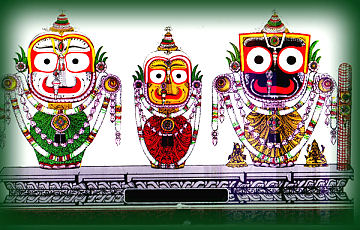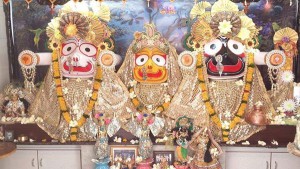The Divine Plan for Jagannatha’s Manifestation
Five thousand years ago, Lord Krishna, along with His elder brother Balarama and His younger sister Subhadra, visited Kurukshetra in a chariot during a solar eclipse. This event became the inspiration for the later manifestation of the deities of Jagannatha, Balarama, and Subhadra. About two thousand years after this visit, King Indradyumna of Orissa, a great devotee of Lord Vishnu, desired to establish a temple in Puri with deities representing this divine journey.
King Indradyumna’s Search for Nila-madhava
The story of Lord Jagannatha’s appearance begins with King Indradyumna hearing about an incarnation of Lord Vishnu known as Nila-madhava. Eager to witness this divine form, the King sent many Brahmanas to search for Nila-madhava. All returned unsuccessful except for Vidyapati, who, after wandering to a distant town, stayed with a tribe known as the Shabaras. Vidyapati married Lalita, the daughter of Visvasu, the tribal leader, who secretly worshiped Nila-madhava.
Vidyapati, after much persuasion, was allowed to see Nila-madhava but only while blindfolded. However, his wife tied mustard seeds in his cloth, creating a trail that could be followed later. Upon seeing Nila-madhava, Vidyapati was overwhelmed with ecstasy. The Deity, however, instructed that He now wished to be worshiped by King Indradyumna.
King Indradyumna’s Temple and the Appearance of Daru-brahman
When King Indradyumna attempted to find Nila-madhava, He had disappeared. Disheartened, the King decided to fast unto death. But in a dream, the Lord assured him that He would appear in the form of Daru-brahman, a divine piece of wood. This wood, marked with symbols of a conch, disc, club, and lotus, was found floating in the sea and was later brought to the shore through the King’s devotion and the Lord’s grace.
The Carving of the Deities
King Indradyumna requested many expert carvers to shape the Deity from Daru-brahman, but none succeeded. Finally, Visvakarma, the architect of the demigods (some say the Lord Himself), arrived as an old artist, Ananta Maharana, and promised to carve the Deities within three weeks if allowed to work behind closed doors. However, after 14 days, the King, growing anxious, opened the doors prematurely, revealing the incomplete forms of Jagannatha, Balarama, and Subhadra.
Though the Deities were unfinished, the Lord revealed to the King that this form was the one meant to be worshiped in Kali-yuga. The King was reassured that these forms were perfect and that the devotees would always see Lord Jagannatha in His full divine glory.
The Ongoing Worship and Significance
Since then, the Deities of Jagannatha, Balarama, and Subhadra have been worshiped in the Jagannatha Puri temple. These forms, though appearing incomplete, are worshiped with deep devotion, especially during the grand Ratha-Yatra festival, where the Lord rides through the streets on massive chariots, allowing all to behold His divine presence.
Lessons to Be Learned from the Story
Divine Will Prevails: The story of Lord Jagannatha’s appearance teaches us that the divine will always manifests, even if it does not align with our expectations or desires. King Indradyumna’s impatience led to the premature revealing of the Deities, but the Lord reassured him that everything was as it should be.
The Power of Devotion: The efforts of King Indradyumna, Vidyapati, and Visvasu highlight the power of devotion. Their unwavering faith and dedication brought forth the manifestation of the Supreme Lord in the form of Jagannatha.
The Lord’s Incomprehensible Nature: The story reminds us that the Lord’s form and pastimes are beyond our material understanding. The incomplete forms of Jagannatha, Balarama, and Subhadra are perfect and complete in the spiritual sense, meant for the specific needs of the current age, Kali-yuga.
Inclusivity of Divine Grace: Lord Jagannatha’s appearance as Daru-brahman, a wooden form, and His subsequent worship in Puri, shows that the divine is accessible to all. His grand appearance during Ratha-Yatra demonstrates His mercy and inclusiveness, as He goes out to meet His devotees, regardless of their social or spiritual standing.
The Eternal Presence of the Lord: The story underscores that the Lord’s presence is eternal and that He manifests in various forms to guide and bless His devotees. The Deity forms of Jagannatha, Balarama, and Subhadra are embodiments of divine love and protection for all who seek refuge in them.
Prayer to Lord Jagannatha
O Jagannatha Swami, Lord of the Universe, May You always be visible before my eyes.
As You revealed Yourself to King Indradyumna, Manifest before me Your divine presence, So that I may serve You with unwavering devotion.
O Lord of mercy, who rides the chariots during Ratha-Yatra, Draw me closer to Your lotus feet, And guide me on the path of righteousness and love.
May Your incomprehensible and divine form, Be ever present in my heart, Filling my life with the joy of Your eternal pastimes.
O Jagannatha, who blesses all who see Your sacred flag, Liberate me from the bonds of material existence, And grant me the vision to see Your eternal beauty.
Hare Krishna, Hare Krishna, Krishna Krishna, Hare Hare, Hare Rama, Hare Rama, Rama Rama, Hare Hare.



